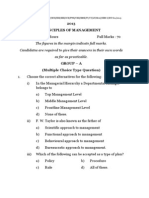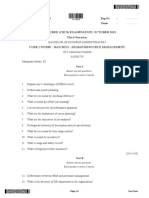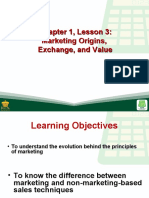Compensation Management Systems - Paper B - 4
Compensation Management Systems - Paper B - 4
Uploaded by
Tremaine AllenCopyright:
Available Formats
Compensation Management Systems - Paper B - 4
Compensation Management Systems - Paper B - 4
Uploaded by
Tremaine AllenOriginal Title
Copyright
Available Formats
Share this document
Did you find this document useful?
Is this content inappropriate?
Copyright:
Available Formats
Compensation Management Systems - Paper B - 4
Compensation Management Systems - Paper B - 4
Uploaded by
Tremaine AllenCopyright:
Available Formats
HRMT3501
THE COUNCIL OF COMMUNITY COLLEGES OF JAMAICA
BACHELOR OF SCIENCE EXAMINATION
SUMMER SEMESTER – 2019 AUGUST
PROGRAMME: BUSINESS ADMINISTRATION
COURSE NAME: COMPENSATION MANAGEMENT SYSTEMS
CODE : HRMT3501
YEAR GROUP: THREE
DATE: THURSDAY, 2019 AUGUST 15
TIME: 9:00 A.M. – 11:00 A.M.
DURATION: 2 HOURS
EXAMINATION TYPE: FINAL
This Examination Paper has 4 Pages
INSTRUCTIONS:
1. ANSWER ALL QUESTIONS FROM SECTION A
2. ANSWER ANY TWO (2) QUESTIONS FROM SECTION B
DO NOT TURN THIS PAGE UNTIL YOU ARE TOLD TO DO SO
19/08 The Council of Community Colleges of Jamaica Page 1
HRMT3501
SECTION A
Instruction: In the booklet provided, answer ALL questions in this section.
COMPENSATION PHILOSOPHY AT AT&T
This company believes that the compensation programme for executives at AT&T should be
designed to attract and retain them for a long period. The compensation philosophy provides a
strong link between achievement of overall company objectives and an executive’s total earning
opportunity. Core principles of this philosophy include competitive compensation opportunities,
performance-based payments and that a significant portion of the total compensation opportunity
should be equity-based (Board Compensation Committee Report on Executive Compensation).
The current compensation philosophy of AT&T is effective in terms of attracting and retaining
employees and high-calibre management personnel. It is also effective as it helps the company to
motivate employees to enhance their performance towards achieving overall organisational goals
and objectives. Compensation provided is externally competitive and internally equitable. All
these are helpful for AT&T to reduce its employee turnover rate and build a sustainable
competitive advantage in the market.
Compensation Philosophy case 2016 May 20
/www.assignmenthelpexperts.com
Question 1
A. Describe THREE (3) compensation philosophies at AT&T, with examples
of how these will enhance the company’s goals. (9
marks)
B. What are TWO (2) additional compensation philosophies that AT&T can
benefit from? (6
marks)
C. State FIVE (5) factors that affect compensation. (5
marks)
19/08 The Council of Community Colleges of Jamaica Page 2
HRMT3501
(Total 20 marks)
END OF SECTION A
SECTION B
Instruction: In the booklet provided, answer any TWO (2) questions from this section.
Question 1
A. Describe the following theoretical perspectives with application to
compensation:
i. Adam’s Equity Theory
ii. Herzberg’s Two-factor Theory (16
marks)
B. Discuss the impact of TWO (2) new and emerging trends in
compensation management. (10
marks)
C. Comment on compensation as a strategic tool. (4
marks)
(Total 30 marks)
Question 2
A. Explain the term ‘salary survey’. (3
marks)
B. Describe FIVE (5) ways in which a salary survey is important to an
organisation. (10
marks)
C. List FOUR (4) job evaluation methods and examine any THREE (3). (13
marks)
D. Assess the purpose of a compensation management policy. (4 marks)
(Total 30 marks)
Question 3
A. Elaborate on ‘pay policy’ and the methodology used in its development. (6 marks)
19/08 The Council of Community Colleges of Jamaica Page 3
HRMT3501
B. Consider FOUR (4) issues in the development of a pay policy. (20
marks)
C. Discuss TWO (2) benefits of a pay policy to a company. (4
marks)
(Total 30 marks)
Question 4
A. Differentiate between ‘dismissal’ and ‘termination’. (6 marks)
B. Discuss legal issues that can affect the dismissal of an employee. (10 marks)
C. Outline steps an HRM practitioner must take to avoid the legal issues
identified at B. Provide relevant examples. (14 marks)
(Total 30 marks)
19/08 The Council of Community Colleges of Jamaica Page 4
HRMT3501
END OF EXAMINATION
THE COUNCIL OF COMMUNITY COLLEGES OF JAMAICA
BACHELOR OF SCIENCE EXAMINATION
SUMMER SEMESTER – 2019 AUGUST
PROGRAMMES: BUSINESS ADMINISTRATION
COURSE NAME: COMPENSATION MANAGEMENT SYSTEMS
CODE : HRMT3501
YEAR GROUP: THREE
DATE: THURSDAY, 2019 AUGUST 15
TIME: 9:00 A.M. -11:00 A.M.
DURATION: 2 HOURS
EXAMINATION TYPE: FINAL
SOLUTIONS
SECTION A
Question 1
Question 1
Discuss three (3) Compensation Philosophies of AT&Ts giving example of how it will enhance
thecompany’s goals. (12 marks)
4 marks for each point given. (3x4= 12 marks)
Students should write on the following:
19/08 The Council of Community Colleges of Jamaica Page 5
HRMT3501
AT&T’s Compensation philosophies are:
competitive compensation opportunities
performance based payments
significant portion of the total compensation opportunity should be equity-based
payment.
Any other to identified that attract and retain staff
Examples provided should be in keeping with the philosophies identified.
Question 2
Outline two (2) additional Compensation Philosophies that AT&T Company can benefit from.
(8marks)
4 marks for each correct answer 4x2=8
Students can write on any of the following:
Team Based pay this encourages team work.
Education assistance while paying for skills according to market value or close to.
Health Care incentives and or employee wellness plan
Any addition can be suggested and determined by the marker to be correct.
Question 3
State five(5) factors that affect compensation. (5 marks)
students can write on any five of the following 1 mark each.
Internal factors-Ability to pay, business strategy, Job evaluation and performance Appraisal,
employee performance.
External factors-labour market, going rate in the industry, productivity, cost of living, labour law,
labour unions.
SECTION B
Question 1
Describe the following theoretical perspectives with applications to Compensation:
(16marks)
(ii) Adam’s Equity Theory: Equity theory is based in the idea that individuals are motivated by
fairness, and if they identify inequities in the input or output ratios of themselves and their
referent group, they will seek to adjust their input to reach their perceived equity. Adams
suggested that the higher an individual's perception of equity, the more motivated they will be
and vice versa: if someone perceives an unfair environment, they will be de-motivated
(iii) Herzberg’s Two-factor Theory: Motivator factors – Simply put, these are factors that lead
to satisfaction and motivate employees to work harder. Examples might include enjoying your
work, feeling recognised and career progression. Hygiene factors – These factors can lead to
dissatisfaction and a lack of motivation if they are absent. Examples include salary, company
policies, benefits, relationships with managers and co-workers.
Four (4) marks will be awarded for detail discussion
19/08 The Council of Community Colleges of Jamaica Page 6
HRMT3501
(B) Discuss two (2) new and emerging trends in compensation management. (10marks)
Insurance Scheme, Company Leased, accommodation.
Two (2) marks for each identified and 4marks for discussion.
(C) Describe Compensation as a strategic tool.
Compensation, a key strategic area for organizations, impacts an employer’s ability to attract
applicants, retain employees, and ensure optimal levels of performance from employees in
meeting the organization’s strategic objectives. Compensation has been advocated by some
recently as a tool for enhancing organizational performance and sustained competitiveness.
Contemporary approaches to compensation emphasize the importance of aligning employee
behaviors to the strategic direction of the organization.
Four (4) marks will be awarded for detail discussion
Question 2
a). Explain the term ‘salary survey’ (3 marks)
Salary Surveys are tools used to determine the median or average compensation paid to
employees in one or more jobs. Compensation data, collected from several employers, is
analyzed to develop an understanding of the amount of compensation paid. Surveys may
focus on one or more job titles, geographic regions, employer size, and or industries. Salary
surveys may be conducted by employer associations (e.g., SHRM), survey vendors, or by
individual employers.
b) Describe five (5) importance of salary survey to organizations. (10 marks)
Salary surveys serve many purposes, ranging from wage determination to competitiveness
in the marketplace to internal salary equity concerns as they arise. Let's take a look at
some other benefits of salary survey usage:
1. Salary surveys help determine wage levels, or how much you'll pay for certain
positions.
2. Salary survey, a business is able to strategically determine various wage levels
based on the market rate for the type of job performed, responsibilities, education level,
experience, and other components. By doing this, an organization is able to set its salary
structure company-wide, which can help decide how many and what types of employees
can be hired.
3. Salary surveys help uncover wage trends, or fluctuations in compensation. Over
time, with changes in the job markets as well as supply and demand, the numbers in a
salary survey will change, fluctuating up or down based on need and importance.
4. Salary Survey can identify compensation structure.
5. Salary Survey can be used in internal wage decision.
c). List four (4) job evaluation methods and explain any three (3) methods.
Ranking Method
Job Classification Method
Factor Comparison Method
Point – Ranking Method
(14 marks)
19/08 The Council of Community Colleges of Jamaica Page 7
HRMT3501
d). Explain the purpose of a compensation management policy. (3 marks)
The purpose of the compensation policy is to provide guidelines for establishing and
administering a compensation plan for Professionals, Professional Faculty and Operational
Employees.
(Total 30 marks)
Question 3
(a) Explain what is a “pay policy” and describe the methodology used in its development.
(6 marks)
Pay Policy: Document created and posted on intranet, copy given to all staff, explaining the
company’s position on compensation and how existing policies can be changed. (3 marks)
Methodology: Use the committee method with representatives from all levels of company so
that they may understand what is a pay policy, and that their major concerns may be reflected
there in. (3marks)
(b) Discuss four issues to be considered in the development of a pay policy (20 marks)
Pay related Issues:
policy governing type of compensation used;
how the amounts are to be arrived at,
whether to lead, lag or match, secret or open pay,
seniority based or performance driven
types of benefits to be offered and how they are to be achieved, ratio of
base to variable pay, criteria for measuring work done.’
External vs internal equity,
Impact of environment on compensation.,
Legality of policies, payment days, use of credit card, lodgement of salaries,
Statutory deductions Etc.
(c) Discuss two the benefits to a company in having a Pay policy. (4 marks)
Benefits:
Common knowledge
Unions can enforce implementation and discourage breaking of it.
Relevant, providing a participatory methodology was used in compiling it.
Reduce industrial action and suits taken out against company
Question 4
a). Differentiate between dismissal and termination. (4 marks)
a. Differentiate between dismissal and termination. (4 marks)
19/08 The Council of Community Colleges of Jamaica Page 8
HRMT3501
Termination is an end of contract, whereas, in dismissal, the employee can be acquitted of
his charges by a court and reinstated back to his job. In termination, there are no benefits
for the employee while there may be some benefits allowed by the management in the case
of dismissal. Dismissal is a sort of punishment for a delinquent employee in case of lost of
trust in employee performance.
b). Discuss the legal issues that can affect the dismissal of an employee. (9 marks)
b. Discuss the legal issues that can affect the dismissal of an employee. (9 marks)
Noncompliance with the law (employment and termination act) Discrimination Equity
Have any of the employee right been breached (contract, promises etc.) Have the
companies dismissal and termination policy been followed.
c). Outline the steps a HRM practitioner must take to avoid the legal issues identified
in b. Provide relevant examples. (12 marks)
c. Outline the steps a HRM practitioner must take to avoid the legal issues identified in b.
Provide relevant examples
Set up employment policies and dispute resolution procedures that make
employees feel treated fairly.
Do the preparatory work that helps to avoid legal issues such as following
the steps for employee dismissal: i. Feedback on performance ii.
Employee training
iii. Documentation
Comply with the law.
Comply with the contractual arrangement stated or implied by the firm
via its employment application forms, employee manuals, or other
promises.
(Total 30 marks)
19/08 The Council of Community Colleges of Jamaica Page 9
You might also like
- Foundation of Business ManagementDocument4 pagesFoundation of Business ManagementIshwor Dhakal100% (2)
- Questions For Master Exam Strategic Management 3 2Document7 pagesQuestions For Master Exam Strategic Management 3 2_dinash100% (8)
- Operation Research Sec BDocument11 pagesOperation Research Sec BTremaine AllenNo ratings yet
- Ohrm 404 Passquo Ob MarvinDocument8 pagesOhrm 404 Passquo Ob MarvinObed AsamoahNo ratings yet
- 8099 - PMRJC24Document3 pages8099 - PMRJC24kaliNo ratings yet
- University of Mauritius: Faculty of Law and ManagementDocument4 pagesUniversity of Mauritius: Faculty of Law and ManagementFadil RushNo ratings yet
- AF301 ExamDocument4 pagesAF301 ExamShikhaNo ratings yet
- PapaerhrmDocument4 pagesPapaerhrmrashshrNo ratings yet
- Previous Jan 2010 PaperDocument20 pagesPrevious Jan 2010 PaperPremchand KalapalaNo ratings yet
- mktg1101 PDFDocument3 pagesmktg1101 PDFRaveesh HurhangeeNo ratings yet
- BHE 401 & BHR 305 Organisation Conflict Management and Industrial RelationsDocument2 pagesBHE 401 & BHR 305 Organisation Conflict Management and Industrial RelationsLinto SophieNo ratings yet
- (Aa33) Business Management and StrategyDocument5 pages(Aa33) Business Management and StrategynvjnjNo ratings yet
- Test 2 - Business EthicsDocument5 pagesTest 2 - Business Ethicsnoor anis shamila ibrahimNo ratings yet
- 12_BS_SPECIAL EXAM_AK_SET BDocument10 pages12_BS_SPECIAL EXAM_AK_SET BbuffybenitaNo ratings yet
- HRM 598 Compensation Entire CourseDocument4 pagesHRM 598 Compensation Entire CoursewillardmrtinNo ratings yet
- All Chapters CompensationDocument43 pagesAll Chapters Compensationactuarialscience99100% (1)
- Department of Management, Industrial Relations and OHS HRM703 - Human Resource Management and Development Final Exam: Trimester I, 2012Document8 pagesDepartment of Management, Industrial Relations and OHS HRM703 - Human Resource Management and Development Final Exam: Trimester I, 2012Manraj LidharNo ratings yet
- 2019 Prelims EQPDocument3 pages2019 Prelims EQPMelody RoseNo ratings yet
- CORPORATE-STRATEGY-AND-GOVERNANCE.pdfDocument6 pagesCORPORATE-STRATEGY-AND-GOVERNANCE.pdfMike NelsonNo ratings yet
- BBS 3207 - Business Strategy and Competitiveness - April 2016Document2 pagesBBS 3207 - Business Strategy and Competitiveness - April 2016faithwambui2001No ratings yet
- HRM Assignment 02Document2 pagesHRM Assignment 02AnubhaNo ratings yet
- Wa0000.Document6 pagesWa0000.RahulNo ratings yet
- b200244c Bbmn3213 Final ExamDocument13 pagesb200244c Bbmn3213 Final ExamBBMK21-A2 You SengNo ratings yet
- Shanti Business School: PGDM Trimester-Iii End Term Examination JULY - 2015Document7 pagesShanti Business School: PGDM Trimester-Iii End Term Examination JULY - 2015SharmaNo ratings yet
- E1 - Enterprise Operations: Enterprise Pillar Operational LevelDocument12 pagesE1 - Enterprise Operations: Enterprise Pillar Operational LevelmavkaziNo ratings yet
- Accounting Theory and Policy - (Final Paper) - International Islamic University MalaysiaDocument6 pagesAccounting Theory and Policy - (Final Paper) - International Islamic University MalaysiaMaas Riyaz Malik100% (1)
- BBDH2013 6Document4 pagesBBDH2013 6rynnalimtxNo ratings yet
- MBA HRM End Term 2021 - FinalDocument5 pagesMBA HRM End Term 2021 - FinalAakash KrNo ratings yet
- Performance Management OnlineDocument6 pagesPerformance Management OnlineTremaine AllenNo ratings yet
- Unisel HRMDocument7 pagesUnisel HRMSubramaniam MaestroNo ratings yet
- B120 MTA MG Set 1 First Semester Fall 2015 - 2016Document7 pagesB120 MTA MG Set 1 First Semester Fall 2015 - 2016HazemNo ratings yet
- Compensation ManagementDocument1 pageCompensation ManagementChirack Singh Tony AntonyNo ratings yet
- Final Question-301-HRMDocument2 pagesFinal Question-301-HRMMd. Saiful Islam100% (1)
- NGM College HRM QP 1Document3 pagesNGM College HRM QP 1Gokul krishnanNo ratings yet
- E1 Nove 2011 QueDocument12 pagesE1 Nove 2011 Quepatrick phiriNo ratings yet
- MHRM CBCS Model Question Papers 2015 16Document23 pagesMHRM CBCS Model Question Papers 2015 16Sunaiyna VarmaNo ratings yet
- Organisational Conflict and NegotiationDocument3 pagesOrganisational Conflict and NegotiationKisean YoungNo ratings yet
- SV Jan 2019 Exam Q.Document4 pagesSV Jan 2019 Exam Q.dylan.cosgrove2000No ratings yet
- HRMT 3113Document3 pagesHRMT 3113Layway McDonaldNo ratings yet
- Business EthicsDocument3 pagesBusiness EthicsAshika JayaweeraNo ratings yet
- WBUT 2013 Principles of Management Question PaperDocument6 pagesWBUT 2013 Principles of Management Question PaperSushovan Nath100% (1)
- End Term Examination: Prof (DR.) Pankaj HandaDocument1 pageEnd Term Examination: Prof (DR.) Pankaj Handarajeevv_6No ratings yet
- Dividend Policy at Linear Technology Study GuideDocument2 pagesDividend Policy at Linear Technology Study GuidePervez MahmudNo ratings yet
- Full Test Bank For Strategic Compensation, 10th Edition, Joseph J. Martocchio All ChaptersDocument39 pagesFull Test Bank For Strategic Compensation, 10th Edition, Joseph J. Martocchio All Chapterswostibnl100% (4)
- Model Question Paper - CIHRM EX III - Business Acumen (CIHRMS9, CIHRMS10)Document4 pagesModel Question Paper - CIHRM EX III - Business Acumen (CIHRMS9, CIHRMS10)aakilar111No ratings yet
- BBA BIM BBM 2nd Semester Model Question-1Document10 pagesBBA BIM BBM 2nd Semester Model Question-1dahalsamriddhi98No ratings yet
- Heq Mar15 Dip Piisp ReportDocument8 pagesHeq Mar15 Dip Piisp ReportNayanaNo ratings yet
- Mba Old Question 2009Document84 pagesMba Old Question 2009RAJASEKAR176No ratings yet
- IGNOU Assignment ECO-03 UnsolvedDocument3 pagesIGNOU Assignment ECO-03 UnsolvedsuneeeelkumarNo ratings yet
- HRM 430 Final ExamDocument5 pagesHRM 430 Final ExamDeVryHelpNo ratings yet
- Part A (Long Answer Type Questions) : (15×2 30 Marks)Document9 pagesPart A (Long Answer Type Questions) : (15×2 30 Marks)Kulshrestha Shwta SNo ratings yet
- 104exmba PDFDocument27 pages104exmba PDFKrishnamohan VaddadiNo ratings yet
- XII Comm, Term 1, CommDocument3 pagesXII Comm, Term 1, Commsriashwanth6No ratings yet
- DeVry HRM 598 Final Exam 100% Correct AnswerDocument3 pagesDeVry HRM 598 Final Exam 100% Correct AnswerDeVryHelpNo ratings yet
- Human Resource ManagementDocument2 pagesHuman Resource ManagementNithin B NairNo ratings yet
- Isc BSTD Suggestion - Part 2Document4 pagesIsc BSTD Suggestion - Part 2Prince RudraNo ratings yet
- Half Yearly - ST IgnatiusDocument16 pagesHalf Yearly - ST IgnatiusuhhwotNo ratings yet
- B.B.A. 1st Sem Exam 2017-18Document22 pagesB.B.A. 1st Sem Exam 2017-18rounakmazumdar250No ratings yet
- p2bDocument5 pagesp2bbloosmxeditNo ratings yet
- Compensation Mangement SystemDocument6 pagesCompensation Mangement SystemTremaine AllenNo ratings yet
- Model answer: Launching a new business in Networking for entrepreneursFrom EverandModel answer: Launching a new business in Networking for entrepreneursNo ratings yet
- Content The United Nations Conference On Sustainable Development 2Document4 pagesContent The United Nations Conference On Sustainable Development 2Tremaine AllenNo ratings yet
- Income Component of HDIDocument26 pagesIncome Component of HDITremaine AllenNo ratings yet
- Performance Management OnlineDocument6 pagesPerformance Management OnlineTremaine AllenNo ratings yet
- Company Law Unit 1Document16 pagesCompany Law Unit 1Tremaine Allen100% (1)
- Lesson 3 MGT207 Escape From Taxation Prepared by SKM (Additional)Document25 pagesLesson 3 MGT207 Escape From Taxation Prepared by SKM (Additional)Alkhair SangcopanNo ratings yet
- Chapter 1, Lesson 3: Marketing Origins, Exchange, and ValueDocument22 pagesChapter 1, Lesson 3: Marketing Origins, Exchange, and ValuePrincess Camille dela PenaNo ratings yet
- Chap4 Approaches For Interaction DesignDocument30 pagesChap4 Approaches For Interaction Designduyb2111789No ratings yet
- Michael E. Gerber - The E-Myth Revisited - Why Most Small Businesses Don't Work and What To Do About It-HarperCollins (1995)Document286 pagesMichael E. Gerber - The E-Myth Revisited - Why Most Small Businesses Don't Work and What To Do About It-HarperCollins (1995)TBSS100% (2)
- Ancillary Services of BanksDocument19 pagesAncillary Services of BanksdebojyotisarkarNo ratings yet
- OS Road Con & Main L-4Document81 pagesOS Road Con & Main L-4BeleteNo ratings yet
- Financial Market (FM) : Market-And Part of Factor Market - Market ForDocument8 pagesFinancial Market (FM) : Market-And Part of Factor Market - Market ForAmeya Phadke100% (1)
- PPD_20230918172537Document472 pagesPPD_20230918172537Logesh SNo ratings yet
- Application Form Group Personal Accident InsuranceDocument112 pagesApplication Form Group Personal Accident InsuranceJayde GonzalesNo ratings yet
- Occupational Safety and Health ActDocument18 pagesOccupational Safety and Health ActJustice Pilot TaperaNo ratings yet
- MCQ QuestionsDocument5 pagesMCQ Questionskushal singhNo ratings yet
- EPW, Vol.58, Issue No.37, 16 Sept 2023Document75 pagesEPW, Vol.58, Issue No.37, 16 Sept 2023DALJEET SINGHNo ratings yet
- Sop PurchasingDocument5 pagesSop PurchasingShivam GaurNo ratings yet
- Wilson Maina Wanjiku Elc. Case No. 376 OF 2018: Completion NoticeDocument1 pageWilson Maina Wanjiku Elc. Case No. 376 OF 2018: Completion NoticeReader S Book LoftNo ratings yet
- My ProposalDocument24 pagesMy Proposalbayisabirhanu567No ratings yet
- Example Annual ReportDocument9 pagesExample Annual ReportAmirul HaziqNo ratings yet
- UntitledDocument2 pagesUntitledTutchangsNo ratings yet
- Digital Public RelationsDocument3 pagesDigital Public Relations121320090016No ratings yet
- AS 17 Segment ReportingDocument11 pagesAS 17 Segment ReportingNishant Jha Mcom 2No ratings yet
- Sample CoopDocument18 pagesSample Coopdavid.ebirformsNo ratings yet
- AI Automation ProposalDocument6 pagesAI Automation ProposalDIVINENo ratings yet
- Absolute AdvantageDocument34 pagesAbsolute Advantageanilk36948100% (2)
- Advertising Between Top N Town and Disnshaw - Ashima SultanDocument25 pagesAdvertising Between Top N Town and Disnshaw - Ashima SultanNitinAgnihotriNo ratings yet
- Fixtructure Construction & Supply Ifs 2017 October Audit CertificateDocument5 pagesFixtructure Construction & Supply Ifs 2017 October Audit CertificateNathaniel Niño TangNo ratings yet
- Microsoft Certified: Power Platform App Maker Associate - Skills MeasuredDocument4 pagesMicrosoft Certified: Power Platform App Maker Associate - Skills MeasuredkarijosephNo ratings yet
- PRD DipankarDocument53 pagesPRD Dipankarh23079No ratings yet
- Geuens Weijters DeWulf 2009 BrandpersonalityDocument12 pagesGeuens Weijters DeWulf 2009 BrandpersonalityVinh VũNo ratings yet
- Globalization Case Analysis: GE's Two Decade Transformation (Jack Welch)Document14 pagesGlobalization Case Analysis: GE's Two Decade Transformation (Jack Welch)mmhoward2088% (24)
- Consumer Behaviour Assignment: What Is Cross Culture?Document10 pagesConsumer Behaviour Assignment: What Is Cross Culture?sajeev georgeNo ratings yet
- Smart WealthDocument8 pagesSmart WealthmilanNo ratings yet





























































































